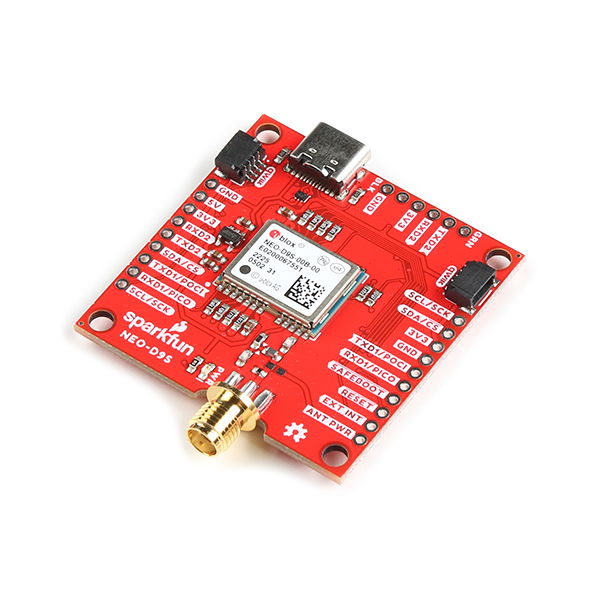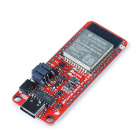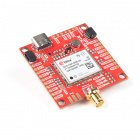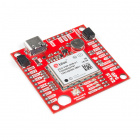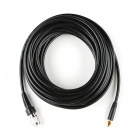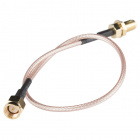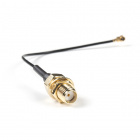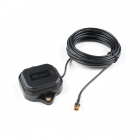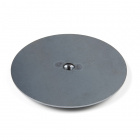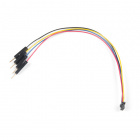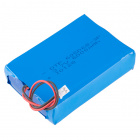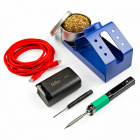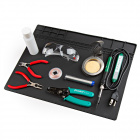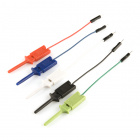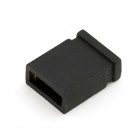Contributors:
 bboyho
bboyho,
 PaulZC
PaulZC Introduction
Please note: The u-blox Thingstream PointPerfect Correction Service is only available to "B2B Customers" (Business To Business Customers). Please check the
Service Terms before purchasing hardware.
The SparkFun GNSS Correction Data Receiver - NEO-D9S is a satellite data receiver for L-band correction broadcast. It can be configured for use with a variety of correction services including u-blox's PointPerfect satellite GNSS augmentation service, which provides homogenous coverage in contiguous USA. With a clear view of the sky, especially a clear view to the South, it decodes the satellite transmission and outputs a correction stream, enabling a multi-band high precision GNSS receiver (such as the u-blox ZED-F9P) to reach accuracies down to centimeter-level positioning without needing a separate RTK or NTRIP correction!
GPS-19390
The SparkFun NEO-D9S GNSS Correction Data Receiver is a satellite data receiver for L-Band correction broadcast.
Required Materials
To follow along with this tutorial, you will need the following materials. You may not need everything though depending on what you have. Add it to your cart, read through the guide, and adjust the cart as necessary.
Arduino Microcontroller
We recommend an Arduino microcontroller with the ability to connect to WiFi. This is useful for those users taking advantage of both the ThingStream PointPerfect Location-as-a-Service over L-Band Satellite and Internet Protocol (IP). The following boards with the ESP32 WROOM module can work.
WRL-20168
The USB-C variant of ESP32 Thing Plus is a development board with WiFi, SPP, BLE, Qwiic connector, 21 I/O pins, RGB status LE…
WRL-19177
The IoT RedBoard is an ESP32 WROOM-equipped development board that has everything you need in an Arduino Uno with extra perks…
High Precision GNSS (HPG) Module
Along with the NEO-D9S, you will need a high precision GNSS (HPG) module from u-blox. As of the writing of his tutorial, the GNSS correction data receiver works for the ZED-F9P module. You will need to make sure that it has the latest firmware when using the modules together.
GPS-16481
The SparkFun GPS-RTK-SMA raises the bar for high-precision GPS and is the latest in a line of powerful RTK boards featuring t…
GPS-15136
The SparkFun GPS-RTK2 is a powerful breakout for the ZED-F9P module. The ZED-F9P is a top-of-the-line module for GNSS & GPS s…
Antennae and Cables
Note: We found that the GNSS Multi-Band L1/L2 Surveying Antenna (TNC) - TOP106 worked for the NEO-D9S L-Band antenna. For users that want a specific active L-Band antenna, you could look at the following antenna listed below.
For the ZED-F9P, you will need a multi-band antenna to take advantage of the L1 and L2 bands. For the NEO-D9S, you will need a L-band antenna. While the GNSS Multi-band L1/L2 Surveying Antenna (TNC) TOP106 was designed for L1 and L2, we found that it was able to pick up the correction data tuned to a frequency within the L-band (1556.29MHz in the US). Make sure to also pick up the TNC to SMA male interface cable and if necessary, an additional SMA extension cable or u.FL to SMA interface cable for the ZED-F9P breakout boards populated with the u.FL connector.
GPS-17751
The TOP106 from TOPGNSS is a certified GNSS/GPS surveying antenna capable of receiving the L1/L2 bands for GPS, GLONASS, Gali…
CAB-21740
This is a 10 meter (33 ft) long Male TNC to Male SMA cable with injection molded stress-relief boots.
WRL-12861
This is a basic SMA (Sub-Miniature A) male to female connector cable. Each cable is 25cm (9.8") long and has a 50Ω impedance…
WRL-18154
A U.FL to SMA (jack) bulkhead straight connector with a 1.32 mm diameter cable.
Retired
You could also use the u-blox or MagmaX2 multi-band antenna for the ZED-F9P and NEO-D9S in the US. However, you would also need the ground plate. Again, while they were designed for L1 and L2, we found that it was also able to pick up the correction data tuned to a frequency within the L-band within the US. You may also need an additional u.FL to SMA interface cable for ZED-F9P breakout boards populated with the u.FL connector.
GPS-15192
The ANN-MB-00 GNSS multi-band antenna is extremely unique from other GNSS/GPS antennas in that it is designed to receive both…
GPS-17519
Using this simple steel plate effectively improves simple patch antenna performance to near professional level antenna setups…
GPS-17108
The AA.200 antenna is an active multiband GNSS magnetic mount antenna that exhibits excellent gain and good radiation pattern…
Retired
WRL-18154
A U.FL to SMA (jack) bulkhead straight connector with a 1.32 mm diameter cable.
Retired
Qwiic Cables
For those that want to take advantage of the Qwiic enabled devices, you'll want to grab a Qwiic cable between each board.
KIT-15081
To make it even easier to get started, we've assembled this Qwiic Cable Kit with a variety of Qwiic cables from 50mm to 500mm…
PRT-14427
This is a 100mm long 4-conductor cable with 1mm JST termination. It’s designed to connect Qwiic enabled components together…
Retired
PRT-14425
This is a jumper adapter cable that comes pre-terminated with a female Qwiic JST connector on one end and a breadboard hookup…
Retired
PRT-14429
This is a 500mm long 4-conductor cable with 1mm JST termination. It’s designed to connect Qwiic enabled components together…
Retired
LiPo Battery
A single-cell Lithium-ion battery can be connected to the ESP32 IoT RedBoard's JST connector. In turn, this will power the NEO-D9S and ZED-F9P for portability.
PRT-13854
These are very slim, extremely light weight batteries based on Lithium Ion chemistry. Each cell outputs a nominal 3.7V at 850…
PRT-13855
These are very slim, extremely light weight batteries based on Lithium Ion chemistry. Each cell outputs a nominal 3.7V at 200…
PRT-13856
If you need some juice, this 6Ah Lithium Ion Battery is for you. These are very compact batteries based on Lithium Ion chemis…
PRT-13813
Slim, extremely light weight batteries based on Lithium Ion chemistry. Each cell outputs a nominal 3.7V at 1000 mAh!
Retired
Tools
Depending on your setup, you may need a soldering iron, solder, and general soldering accessories for a secure connection when using the plated through holes.
KIT-24063
The PINECIL Soldering Iron Kit provides a compact powerhouse and everything you need to ignite your DIY dream.
TOL-09163
This is your basic tube of unleaded (Pb-free) solder with a no clean, water soluble resin core. 0.031" gauge and 15 grams
Bundled Kits! Check out the following tool kits with some of the soldering irons and accessories listed earlier!
TOL-11805
This assortment of tools is great for those of you who have experience with tools but need a fresh set of new parts for your …
Retired
TOL-22265
This assortment of tools is great for those who need a solid set of tools to start your workbench on the right foot!
Retired
Prototyping Accessories
Depending on your setup, you may want to use IC hooks for a temporary connection. However, you will want to solder header pins to connect devices to the plated through holes for a secure connection.
PRT-12002
This is your tried and true white solderless breadboard. It has 2 power buses, 10 columns, and 30 rows - a total of 400 tie i…
PRT-00116
A row of headers - break to fit. 40 pins that can be cut to any size. Used with custom PCBs or general custom headers.
CAB-09741
These are good quality IC test hooks with a male connection wire. Instead of a single hook, these have two hooks that are cap…
PRT-09044
These are two pin jumpers (also called shunts) that will create an electrical connection between two pin headers. Commonly us…
You Will Also Need
Please note: The u-blox Thingstream PointPerfect Correction Service is only available to "B2B Customers" (Business To Business Customers). Please check the
Service Terms before purchasing hardware.
You will need access to dynamic keys to decrypt the correct data sent from an L-band satellite. Users will need to purchase a pricing plan with the ThingStream PointPerfect Location-as-a-Service over L-Band Satellite. You can also purchase a pricing plan that includes the L-Band and Internet Protocol (IP).
From March 10th 2025, the u-blox PointPerfect service will only offered for the USA's contiguous 48 states and up to 12 nautical miles (roughly 22 kilometers) off coastlines. The EU L-Band service is being suspended on that date. Please see u-blox website for additional information. Make sure to check back on the u-blox's website to see if there is additional coverage in your region.
- Contiguous USA (L-band + IP)
- All states, excluding Alaska, Hawaii, and offshore US territories
Note: While they recently updated the coverage to support South Korea, it seems to be only available over IP only. SPARTN correction messages do not appear be listed under their topics for L-band reception yet.
Suggested Reading
If you aren't familiar with the Qwiic system, we recommend reading here for an overview.
We would also recommend taking a look at the following tutorials if you aren't familiar with them.
GPS Basics
The Global Positioning System (GPS) is an engineering marvel that we all have access to for a relatively low cost and no subscription fee. With the correct hardware and minimal effort, you can determine your position and time almost anywhere on the globe.
Logic Levels
Learn the difference between 3.3V and 5V devices and logic levels.
I2C
An introduction to I2C, one of the main embedded communications protocols in use today.
How to Work with Jumper Pads and PCB Traces
Handling PCB jumper pads and traces is an essential skill. Learn how to cut a PCB trace, add a solder jumper between pads to reroute connections, and repair a trace with the green wire method if a trace is damaged.
What is GPS RTK?
Learn about the latest generation of GPS and GNSS receivers to get 14mm positional accuracy!

